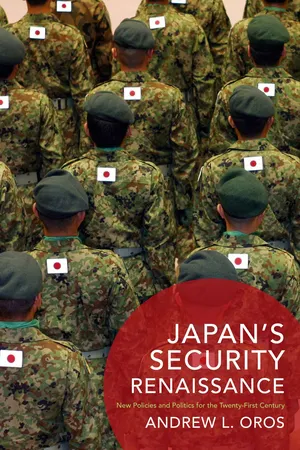
Japan's Security Renaissance
New Policies and Politics for the Twenty-First Century
- English
- ePUB (mobile friendly)
- Available on iOS & Android
About This Book
For decades after World War II, Japan chose to focus on soft power and economic diplomacy alongside a close alliance with the United States, eschewing a potential leadership role in regional and global security. Since the end of the Cold War, and especially since the rise of Prime Minister Shinzo Abe, Japan's military capabilities have resurged. In this analysis of Japan's changing military policy, Andrew L. Oros shows how a gradual awakening to new security challenges has culminated in the multifaceted "security renaissance" of the past decade.
Despite openness to new approaches, however, three historical legacies—contested memories of the Pacific War and Imperial Japan, postwar anti-militarist convictions, and an unequal relationship with the United States—play an outsized role. In Japan's Security Renaissance Oros argues that Japan's future security policies will continue to be shaped by these legacies, which Japanese leaders have struggled to address. He argues that claims of rising nationalism in Japan are overstated, but there has been a discernable shift favoring the conservative Abe and his Liberal Democratic Party. Bringing together Japanese domestic politics with the broader geopolitical landscape of East Asia and the world, Japan's Security Renaissance provides guidance on this century's emerging international dynamics.
Frequently asked questions
Information
| Name | Party | Dates in Office |
| Shinzō Abe | LDP | 12/26/2012– |
| Yoshihiko Noda | DPJ | 9/2/2011–12/26/2012 |
| Naoto Kan | DPJ | 6/8/2010–9/2/2011 |
| Yukio Hatoyama | DPJ | 9/16/2009–6/8/2010 |
| Tarō Asō | LDP | 9/24/2008–9/16/2009 |
| Yasuo Fukuda | LDP | 9/26/2007–9/24/2008 |
| Shinzō Abe | LDP | 9/26/2006–9/26/2007 |
| Jun’ichirō Koizumi | LDP | 4/26/2001–9/26/2006 |
| Yoshirō Mori | LDP | 4/5/2000–4/26/2001 |
| Keizō Obuchi | LDP | 7/30/1998–4/5/2000 |


Table of contents
- Cover
- Series Page
- Title Page
- Copyright
- Dedication
- Contents
- List of Figures and Tables
- Preface
- Note on Asian Family and Place-Names
- List of Abbreviations and Acronyms
- Map of Japan and Its Region
- One. Japan’s Twenty-First-Century Security Renaissance
- Two. The Gradual Awakening
- Three. Japan’s Relative Decline and New Security Challenges in a Multipolar Asia
- Four. Domestic Power Transitions and Japan’s Evolving Strategic Posture, 2006 to 2012
- Five. The New Conservative Mainstream and New Security Policies Under Prime Minister Shinzō Abe, 2012 to 2016
- Conclusion: Implications and Next Steps in Japan’s Security Renaissance
- Appendix 1: Japanese Prime Ministers and Party Affiliations, 2000 to 2016
- Appendix 2: Percentage of Party Vote and Seats in National Elections, 2005 to 2016
- Appendix 3: Selected Historical Apology Statements by Japanese Officials, 1993 to 2015
- Notes
- Bibliography
- Index